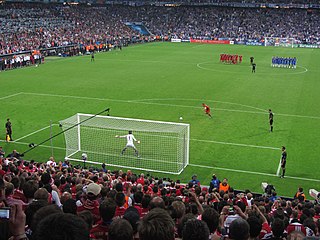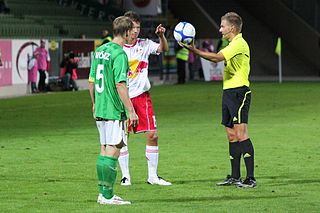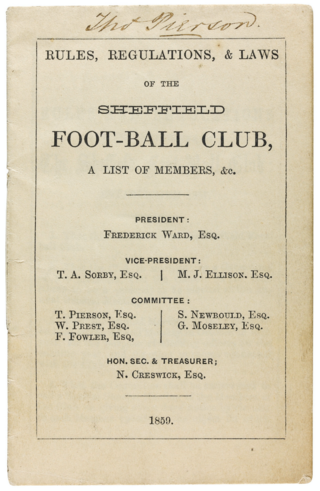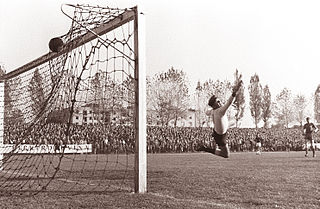Related Research Articles

Canadian football, or simply football, is a sport in Canada in which two teams of 12 players each compete on a field 110 yards (101 m) long and 65 yards (59 m) wide, attempting to advance a pointed oval-shaped ball into the opposing team's end zone.
The golden goal is a sports rule used in association football, Australian rules football, bandy, field hockey, ice hockey, lacrosse, and rugby league to decide the winner of a match in which scores are equal at the end of regular time. It is a type of sudden death. Under this rule, the game ends when a goal or point is scored; the team that scores that goal or point during extra time is the winner. Introduced formally in 1993, though with some history before that, the rule ceased to apply to most FIFA-authorized football games in 2004. The similar silver goal supplemented the golden goal between 2002 and 2004.

Offside is one of the laws in association football, codified in Law 11 of the Laws of the Game. The law states that a player is in an offside position if any of their body parts are in the opponents' half of the pitch, and closer to the opponent's goal line than both the ball and the second-last opponent.

Futsal is a football-based sport played on a hardcourt like a basketball court, smaller than a football pitch, and mainly indoors. It has similarities to five-a-side football and indoor football.

A penalty kick is a method of restarting play in association football, in which a player is allowed to take a single shot at the goal while it is defended only by the opposing team's goalkeeper. It is awarded when an offence punishable by a direct free kick is committed by a player in their own penalty area. The shot is taken from the penalty spot, which is 11 metres from the goal line and centered between the touch lines.

In association football, a penalty shoot-out is a tie-breaking method to determine which team is awarded victory in a match that cannot end in a draw, when the score is tied after the normal time as well as extra time has expired. In a penalty shoot-out, each team takes turns shooting at goal from the penalty mark, with the goal defended only by the opposing team's goalkeeper. Each team has five shots which must be taken by different players; the team that makes more successful kicks is declared the victor. Shoot-outs finish as soon as one team has an insurmountable lead. If scores are level after five pairs of shots, the shootout progresses into additional "sudden-death" rounds. Balls successfully kicked into the goal during a shoot-out do not count as goals for the individual kickers or the team, and are tallied separately from the goals scored during normal play. Although the procedure for each individual kick in the shoot-out resembles that of a penalty kick, there are some differences. Most notably, neither the kicker nor any player other than the goalkeeper may play the ball again once it has been kicked.
In a sport or game, sudden death is a form of competition where play ends as soon as one competitor is ahead of the others, with that competitor becoming the winner. Sudden death is typically used as a tiebreaker when a contest is tied at the end of regulation (normal) playing time or the completion of the normal playing task.
Overtime or extra time is an additional period of play specified under the rules of a sport to bring a game to a decision and avoid declaring the match a tie or draw where the scores are the same. In some sports, this extra period is played only if the game is required to have a clear winner, as in single-elimination tournaments where only one team or players can advance to the next round or win the tournament and replays are not allowed.
The penalty shootout is a method of determining a winner in sports matches that would have otherwise been drawn or tied. The rules for penalty shootouts vary between sports and even different competitions; however, the usual form is similar to penalty shots in that a single player takes one shot on goal from a specified spot, the only defender being the goalkeeper. If the result is still tied, the shootout usually continues on a "goal-for-goal" basis, with the teams taking shots alternately, and the one that scores a goal unmatched by the other team is declared the winner. This may continue until every player has taken a shot, after which players may take extra shots, until the tie is broken, and is also known as "sudden death".
The Laws of the Game are the codified rules of association football. The laws mention the number of players a team should have, the game length, the size of the field and ball, the type and nature of fouls that referees may penalise, the offside law, and many other laws that define the sport. During a match, it is the task of the referee to interpret and enforce the Laws of the Game.

A corner kick, commonly known as a corner, is the method of restarting play in a game of association football when the ball goes out of play over the goal line, without a goal being scored and having last been touched by a member of the defending team. The kick is taken from the corner of the field of play nearest to the place where the ball crossed the goal line.
The away goals rule is a method of tiebreaking in association football and other sports when teams play each other twice, once at each team's home ground. Under the away goals rule, if the total goals scored by each team are equal, the team that has scored more goals "away from home" wins the tiebreaker. This is sometimes expressed by saying that away goals "count double" in the event of a tie, though in practice the team with more away goals is simply recorded as the victor, rather than having additional or 'double' goals added to their total.

A goal kick is a method of restarting the play in a game of association football. Its procedure is dictated by Law 16 of the Laws of the Game.

A throw-in is a method of restarting play in a game of association football when the whole of ball passes over the touchline. It is governed by Law 15 of the Laws of the Game. In Scotland it is known as a shy.

A dropped-ball is a method of restarting play in a game of association football. It is used when play has been stopped due to reasons other than normal gameplay, fouls, or misconduct. The situations requiring a dropped-ball restart are outlined in Law 8 and Law 9 of the Laws of the Game; Law 8 also contains the dropped-ball procedure.

A kick-off is the method of starting and, in some cases, restarting play in a game of association football. The rules concerning the kick-off are part of Law 8 of the Laws of the Game.

The Sheffield Rules was a code of football devised and played in the English city of Sheffield between 1858 and 1877. The rules were initially created and revised by Sheffield Football Club, with responsibility for the laws passing to the Sheffield Football Association upon that body's creation in 1867. The rules spread beyond the city boundaries to other clubs and associations in the north and midlands of England, making them one of the most popular forms of football during the 1860s and 1870s.

In games of association football, teams compete to score the most goals. A goal is scored when the ball passes completely over a goal line at either end of the field of play between two centrally positioned upright goal posts 24 feet (7.32 m) apart and underneath a horizontal crossbar at a height of 8 feet (2.44 m) — this frame is itself referred to as a goal. Each team aims to score at one end of the pitch, while preventing their opponents from scoring at the other end. Nets are usually attached to the goal frame to catch goalscoring balls, but the ball is not required to touch the net.

A free kick is a method of restarting play in association football. It is awarded after an infringement of the laws by the opposing team.
London v. Sheffield was an association football game played on 31 March 1866. According to Charles Alcock, it was the "first match of any importance under the auspices of the Football Association".
References
- 1 2 "Laws of the Game 2018/19" (PDF). theifab.com. IFAB. p. 91. Archived (PDF) from the original on 2019-01-25. Retrieved 2019-01-24.
- ↑ "Laws of the Game 2016/17" (PDF). p. 113. Archived (PDF) from the original on 2017-04-06. Retrieved 2019-01-25.
- ↑ "Laws of the Game 2015/2016" (PDF). fifa.com. FIFA. p. 35. Archived (PDF) from the original on 2021-07-12. Retrieved 2019-01-25.
- ↑ "The Revised Laws: X -- Method of Scoring". Evening Telegraph. Dundee: 8. 1938-07-26.
- ↑ e.g. "Procedures to Determine the Winner of a Match or Home-And-Away", in "Laws of the Game 2015/2016" (PDF). fifa.com. FIFA. pp. 55–57. Archived (PDF) from the original on 2021-07-12. Retrieved 2019-01-25.
- ↑ "Carabao Cup games to go straight to penalties after EFL removes extra time". 8 June 2018. Retrieved 2019-06-12.
- ↑ This was true even of the form of football played at Rugby school, where the predecessor of today's try was, as the name suggests, of value only because of the opportunity it offered to "try" to score a goal by kicking the ball through the posts, in the predecessor of today's conversion.
- ↑ – via Wikisource.; emphasis added
- ↑ "Civil Service v. Barnes Club". The Sportsman (156): 4. 1866-12-13.
- ↑ "London v Sheffield". Bell's Life in London (2294): 10. 1866-04-07.
- ↑ – via Wikisource.
- ↑ "Kicking Behind Goal Line". Field: 424. 1867-11-23.
- ↑ – via Wikisource.
- ↑ "En Passant". Athletic News: 1. 1923-04-02.
This change is not quite so unnecessary as it might appear, for matches have been decided by corner-kicks to prevent replays in charity games late in the season.
- ↑ Farrell, Gerard (1 October 2015). "The 1945 Inter-City Cup: War, Goals, Controversy and death by corner kicks". Bohemian FC . Retrieved 16 August 2017.
- ↑ DeLoughry, Sean (28 May 2015). "Ireland - Dublin City Cup Winners". Rec.Sport.Soccer Statistics Foundation . Retrieved 16 August 2017.
- ↑ "International Football Association Board: 1970 Minutes of the Annual General Meeting" (PDF). p. 6. Archived (PDF) from the original on 2019-01-25. Retrieved 2019-01-24.
- ↑ "International Football Association Board: 1993 Minutes of the Annual General Meeting" (PDF). p. 29. Archived (PDF) from the original on 2019-01-26. Retrieved 2019-01-25.
- ↑ "Amendments to the Laws of the Game -- 2004" (PDF). p. 4. Archived (PDF) from the original on 2019-01-26. Retrieved 2019-01-25.